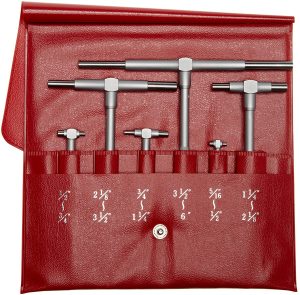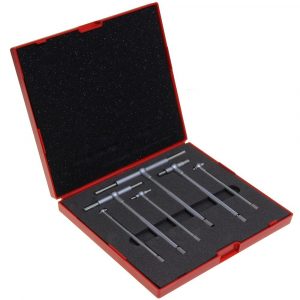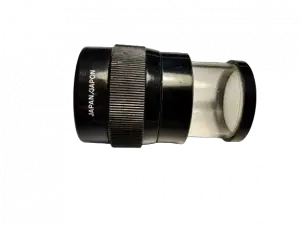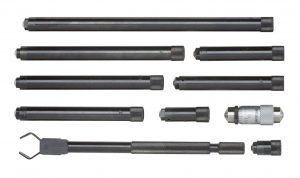Telescoping gages are an extremely useful measuring tool for checking all types of internal features on a part.
They are a perfect complement to a nice set of outside micrometers. It’s important to have a quality set of micrometers and for many, it’s a necessity to have a quality set of telescoping gages.
The best telescoping gages are made by the usual suspects. Both Mitutoyo and Starrett have a long history of making quality telescoping gages. But who wins out? Read on to find out.
Table of Contents
ToggleBest overall
Starrett S579HZ Self-Centering Telescoping Gauge
Measuring tools by Starrett are typically referenced as the gold standard when it comes to telescoping gages, but it is debatable whether they are good enough to warrant the added cost when compared to the Mitutoyos. Both are great sets.
The Starrett set gets the edge by a small margin. Like so many other precision tools, the importance of the “feel” of the tool can not be overstated.
The locking mechanism works exceptionally smooth and the spring action is everything you would hope for also.
Telescoping gages are very much a “feel” tool and as a result the smoothness of the internal workings is of the utmost importance. Just like their micrometers, the telescoping gages by Starrett work exactly as intended and do it very well while being extremely accurate.
Runners-up
Mitutoyo 155-903 6 Piece Telescoping Gage Set
Please note that I am basically a big Mitutoyo fanboy. They just make excellent measuring equipment. Starrett does too, but through their whole catalog I believe Mitutoyo is generally of higher quality.
That’s one reason to take note that the Starrett telescoping set won our best overall here. They are just that good.
Basically everything that was said about the Starrett set applies to this set from Mitutoyo. The Starrett set is a little bit smoother and feels just a touch more solid.
In saying that though, it is hard to imagine being disappointed in either set and the Mitutoyo set comes at a decent price reduction compared to the Starretts which is why it warrants mentioning even though it got beat out by the Starrett set.
Pick one. Go with whichever one is your precision gauge manufacturer of choice and you won’t be sad you did. Treat it right and you’ll have a tool your grandchildren can use. Both Starrett and Mitutoyo are heirloom quality.
Anytime Tools Telescoping Bore Gauge Set
If you absolutely must go with a budget brand, Anytime Tools has a decent track record. They won’t be the same heirloom quality tools as you find from Starrett and Mitutoyo, but they do work well for most people.
If you need to measure to tolerances tighter than .001”, I recommend getting either the Starrett or Mitutoyo set. If .001” is close enough, then go with a cheaper set.
One thing I always say when going with super budget tools is to check them when you get them. If they don’t work as intended or are inaccurate, then send them packing. Most online retailers have lenient return policies.
As a side note, I only wish some of the top tier toolmakers would catch on and provide a case similar to the cheaper units. For whatever reason, telescoping gages have historically come in a strange plastic sleeve holder. These sleeves simply do not provide the amount of protection most would want for a precision measuring instrument.
Frequently asked questions
What is a telescoping gage?
Telescoping gage parts
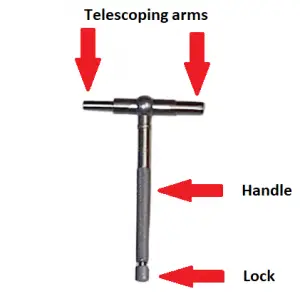
A telescoping gage is a tool used in conjunction with a micrometer to measure the size of internal holes, slots, and similar features. They are usually sold in sets which cover a specified measuring range.
Some varieties have two telescoping arms while others have one. They are simply different styles of the same tool and neither style is preferable to the other.
What are telescoping gages used for?
Telescoping gages are used to measure internal features of a part such as a hole diameter or a slot width. They are versatile and capable of covering a large measuring range, especially when compared to other internal feature measurement tools such dial bore gages and inside micrometers.
What is the measuring range of a telescoping gage?
Telescoping gages come in many different sizes. Typically, they are purchased as sets with a range of 5/16” or ½” up to 6”. Smaller sets are available also and individual gages may be purchased as well.
Some typical individual gage measuring ranges are listed below.
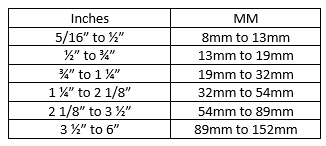
How accurate are telescoping gages?
The accuracy of any telescoping gage depends on multiple factors. The accuracy of the micrometer that is used together with the telescoping gage affects the accuracy most of all.
Additionally, the quality of the telescoping gage, as well as the cleanliness and surface finish of the measured part play a role as well. Parts with a rougher surface finish will not be measured as accurately as those with a smoother surface finish.
The skill of the tool user is another factor in the accuracy of a telescoping gages. Some experienced machinists claim to measure to an accuracy of .0002” while many would argue that .001” is the limit when it comes to telescoping gages. Personally I believe that .0005″ is a more easily attained accuracy with some practice.
The best way to improve your accuracy using telescoping gages is to measure the feature multiple times (3-5) to build confidence in the repeatability of your measurement.
A good way to practice this skill is to measure calibrated ring gauges repeatedly and compare your readings to those of the known ring gauge size.
How to use a telescoping gage
To use a telescoping gage, compress the measuring arms and insert them into the feature to be measured. Gently rock the tool until you feel it “center up” on the feature. Rock it through the hole one time only.
Lock the tool and gently remove the gage from the hole or slot and measure the distance between the measuring faces with a micrometer. Be gentle with your micrometer measurement because excessive force can cause the telescoping gauge to give a smaller reading.
Do you need to calibrate telescoping gages?
Telescoping gages do not need to be calibrated. They should however be inspected to verify they are in good working order.
This inspection should consist of:
- Verifying the spring mechanism is in good working order
- Verifying the locking mechanism is in good working order
- Visually inspect for flat spots or other signs of wear on the contact ends. An eye loupe or pocket comparator come in handy for this check.
As noted in our accuracy section, checking a known ring gauge can allow to develop some certainty that the tool is working as intended.
Telescoping gages vs inside micrometers
Inside micrometers provide more accuracy than telescoping gauges but they do it at the expense of ease of use.
In most instances you will find that a set of telescoping gages will provide readings that are accurate enough and quicker to use or a dial bore gage will be much more accurate and still faster to use, especially in high volume shops.
Inside micrometers have their uses, but many will find them not needed.
Telescoping gages vs dial bore gages
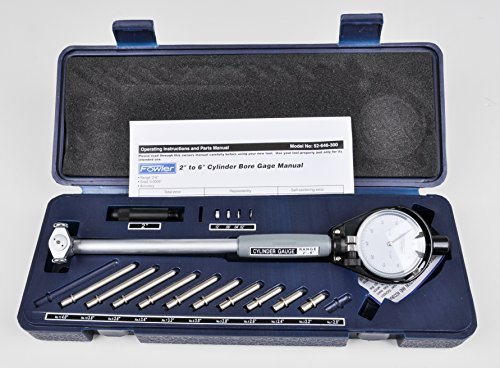
Dial bore gauges are more accurate than telescoping gauges. The accuracy of a dial bore gauge will depend upon the accuracy and resolution of its dial indicator.
Telescoping gages will be accurate to about a thousandth (.001”), possibly more in the hands of an experienced user. Dial bore gauges can easily be found that are accurate to a tenth (.0001”) or better.
The measuring range of dial bore gages varies but is generally quite a bit smaller than that of the telescoping gages or an inside micrometer set.

